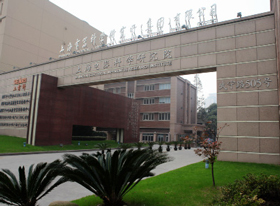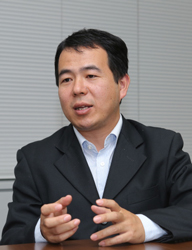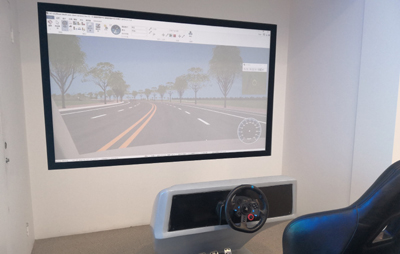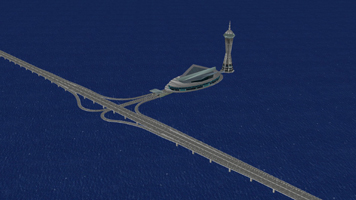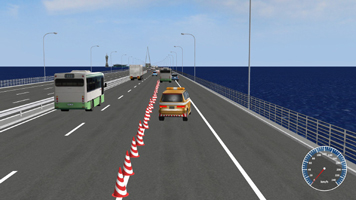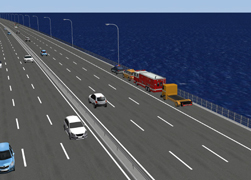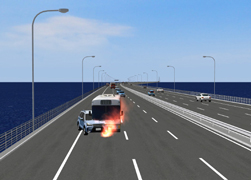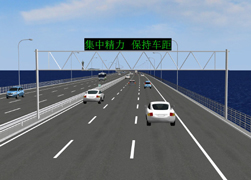|
It was 1953 that the Research Institute was founded. At that time, the Institute was mainly engaged in research and development of electrical apparatus and machinery including dynamo-electric equipment and household electric appliances. Around 1990, he belonged to Automation Office in the Institute, where research and development of controllers and automation were conducted. The products treated in the Office were smaller in size than those of other divisions. In addition, though being a small organization (consisting of about 50 employees), they were proud of "(taking charge of) advanced work (suggesting potentiality) associated with computers and data processing", according to him.
After 1990, with the development of science and technology in China and expansion of the domestic market as its background, the Office started automation of treatment of wastewater and drainage, and then development and integration of transportation systems gradually. In such a stream, the Office soon expanded into an organization of over 100 employees. Finally in 2008, the Office became independent as current "Shanghai SEARI Intelligent System Co., Ltd." (SEISYS).
At the beginning of foundation, SEISYS was engaged mainly in smart transportation with roads as its core. Through more than 10 years afterwards, SEISYS has expanded its business to include:
1) Smart transportation including roads in certain areas, expressways connecting cities, and public transport such as subway, tram, and bus;
2) Smart architecture including building management;
3) Smart Cities including wastewater and drainage treatment services; and additionally in recent years,
4) AI (artificial intelligence)-related services based on big data.
Currently, with more than 750 employees, SEISYS is performing unique marketing activities in almost all parts of the nation (more than 30 Provincial-level divisions) based in not only the headquarters in Shanghai but also in 4 offices in Nanjing (Jiangsu Province), Hangzhou (Zhejiang Province), Tianjin and Chengdu (Sichuan Province), as well as Joint corporations in Urumqi (Xinjiang Uyrur Autonomous Region).
Efforts of Division on Smart Transportation as Its Core
In SEISYS, "High-speed Bridge and Tunnel Division" that Mr. Yanghua Zhou belongs literally takes charge of making expressways, bridges, and tunnels smart. Currently, about 100 employees are members of the Office. The Division places special weights on services including monitoring electric equipment of expressways, information management through all the phases from construction to maintenance of expressways, and system construction of ETC (Electronic Toll Collection System) and its information management / operation.
"In recent years in China, construction of ETC system has been promoted on the national scale."
This means that tollgates are installed for every border of administrative districts in the nation. Since it is necessary to make payment every time a driver passes there, it has become a social problem that large-scale traffic jam occurs especially in holidays where there are many windows that need manual operation. As its solution, additional installment of ETC has been attracting attention. The Division is engaged in ETC system construction and information management mainly in Shanghai, Tianjin, Xinjiang Uyrur Autonomous Region, Zhejiang Province, and Hubei Province. Traditionally, it was only 20% of automobiles passing the tollgates that used ETC. Now through these additional systems, the goal is set to achieving about 90% cover rate by the end of 2019, according to Mr. Zhou.
"(By this) for example, though it might take 3 to 4 hours to drive from Shanghai to Hangzhou in a traditional way (using the window for manual operation), it is expected that use of ETC will enable to reduce the time to 1 to 2 hours."
In addition, he mentioned the response to accidents that occurred on the expressway, in connection with functions of smart roads. For example, traditionally, the drivers who discovered an accident around the spot or the fellow occupant had to inform it. On the contrary, the smart road is equipped with cameras and sensors with high definition on the side of the road, which make it possible to grasp the occurrence of accidents, rescue arrangement, provision of traffic information according to the road conditions etc. more efficiently, says Mr. Zhou.
Knowledge about advanced technologies for relevant hardware and software is indispensable to construct these systems. Since they have been paying close attention to the field of smart transportation systems (or ITS) from the beginning, Mr. Zhou "has been studying ITS in Japan such as VICS and ETC 2.0." He says that it is his role to plan system construction in consideration of research on such information, procurement of necessary resources, and personnel distribution.
|
3D
Simulation system of emergency rescue drill for road traffic operation based on 3D VR and multi-user cooperative operation
|
Developing Simulation System of Emergency Rescue Drill for Long Span Bridges Using UC-win/Road
As mentioned before, it was 2010 that Mr. Yanghua Zhou, Deputy Chief Engineer saw the video showing the completed figure of Shanghai Hongqiao comprehensive transportation hub and its surrounding area (Hongqiao transportation hub), which was promoted in connection with Shanghai Expo that he had been involved in for its construction and which was before completion yet, represented in VR by chance. Hongqiao transportation hub forms a complicated highway structure by accumulating the connecting function with the airport, the rapid transit terminal station, the subway transfer station, and terminals for long distance coaches and fixed-route bus in the city. These are realistically represented by VR in the stage of construction. Mentioning the present situation that examination is being made about how to organize signs and guiding systems in Traffic Police based on the VR, he says that the advantages of such method impressed him strongly in terms of safety and cost, too.
|
Although he had no chance to use VR for work for a while until 2016, when Mr. Zhou took charge of the project of investigating how to link respective divisions efficiently to lead to evacuation and rescue on the occasion of an emergency occurring on Hangzhou Bay Bridge. Then he came up with an idea of using UC-win/Road.
Hangzhou Bay Bridge was completed in 2008. With the length of 35,673m, it was the longest bay bridge in the world at that time. Even today, it is the third longest bridge next to Hong Kong-Zhuhai-Macau Bridge (HZMB) (bridge length: 49,968m) and Jiaozhou Bay Bridge (bridge length: 41,580m).
In case that big accidents or fires occur in such environment, it is indispensable for the headquarters of superintendence and diverse relevant divisions such as for police, fire-fighting, emergency medicine, maintenance of bridge equipment, and wrecker to perform evacuation and rescue efficiently by connecting and collaborating with each other. For this purpose, firstly, 3D space of the site was reproduced by VR using UC-win/Road. Then for the procedure of "who enters the site first, and in what kind of order the others follow" when a fire or accident occurs, an approach of performing the drill using simulation was worked out. A simulation system for training emergency rescue was developed by Mr. Zhou and others.
This system does not allow participants to see each other's movement directly, but allows the movement of the whole at the monitor center. Like this, it reflects special requirements of the drill. Concerned staff in multiple divisions receive training of how to perform efficient cooperation and collaboration while simulating directions, information and communication, and cooperative operation etc. in the same VR space through different network terminals. Moreover, it is so designed as to lead the training results to improvement in the actual operation procedure.
|
|
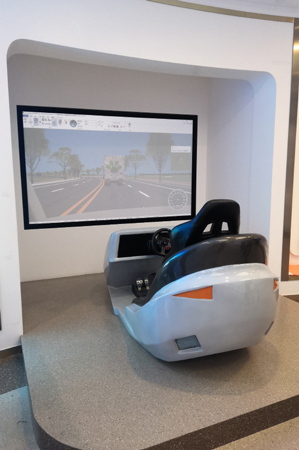 |
| Drive simulator for drill using UC-win/Road |
|
|
"Since this kind of simulation allows us to see the whole stream of drill, I think that good points and points to improve (of our activities) are made clear, leading to smoother cooperation."
In this sense, though originally simulation for drill was assumed, its potential as a tool to evaluate or test the prompt and flexible capacity of the test subjects for response to unexpected accidents attracted attention. Therefore, such functions are also added. Furthermore, as it was the first time for him and others to use UC-win/Road, they learned how to operate it by having support from the FORUM8 staff. When plural relevant members were operating the simulator at the same time, it was a little bit difficult to operate, for example, in synchronizing the image contents accurately. However, they finally cleared the tough part, says Mr. Zhou. |
Potential of UC-win/Road Attracts Attention with Future Application Expected
"We'd like to continue applying UC-win/Road positively."
Through the Design Festival of this time, Mr. Zhou realized its rich functions again by watching diverse application cases. For example, according to him, 3D VR that links spaces above ground and underground infers potentiality to use for confirmation in projects of road development and wastewater / drainage treatment.
In addition, he also mentions ideas about new application of UC-win/Road to the field of smart transportation which they emphasize most, also considering linking with actual vehicle data acquired using a development kit "UC-win/Road SDK".
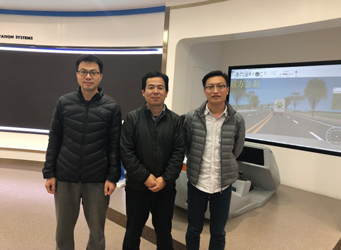 |
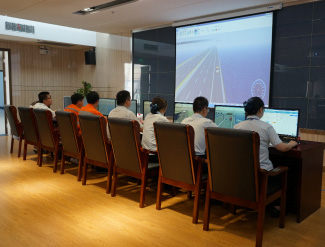 |
| Development members |
Rehearsal of system operation |
|
